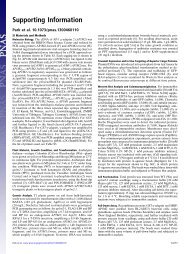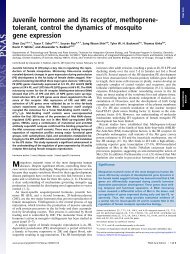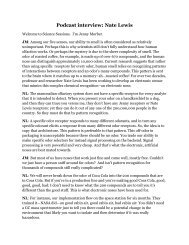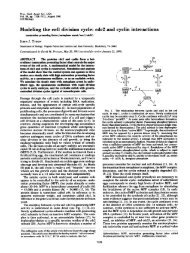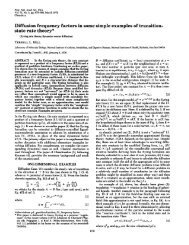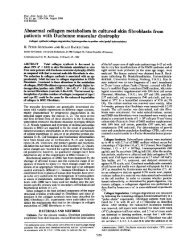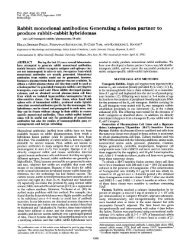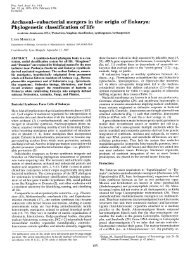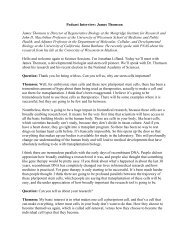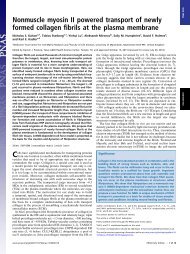Floral homeotic genes are targets of gibberellin signaling in flower ...
Floral homeotic genes are targets of gibberellin signaling in flower ...
Floral homeotic genes are targets of gibberellin signaling in flower ...
You also want an ePaper? Increase the reach of your titles
YUMPU automatically turns print PDFs into web optimized ePapers that Google loves.
Fig. 2. In situ localization <strong>of</strong> AP3 expression <strong>in</strong> WT plants (A–C) and ga1-3 mutants (D–F). (A and D) An<strong>in</strong>florescence apex with stage-2 and stage-4 <strong>flower</strong>s.<br />
(B and E) A stage-8 <strong>flower</strong>. (C and F) A stage-10 <strong>flower</strong>. (Bars � 100 �m.)<br />
<strong>in</strong> the nucleus, perhaps as a transcriptional regulator (42). To<br />
further elucidate the mechanistic l<strong>in</strong>ks between GA <strong>signal<strong>in</strong>g</strong><br />
and the activity <strong>of</strong> downstream <strong>genes</strong> <strong>in</strong> <strong>flower</strong> development, we<br />
created a steroid-<strong>in</strong>ducible version <strong>of</strong> RGA <strong>in</strong> transgenic plants<br />
conta<strong>in</strong><strong>in</strong>g the RGA prote<strong>in</strong> fused to the hormone-b<strong>in</strong>d<strong>in</strong>g<br />
doma<strong>in</strong> <strong>of</strong> a rat GR under the control <strong>of</strong> a 35S promoter.<br />
Posttranslational activation <strong>of</strong> RGA can be achieved <strong>in</strong> plants<br />
transgenic for this construct by dexamethasone treatment, which<br />
releases the fusion prote<strong>in</strong> bound <strong>in</strong> the cytoplasm by means <strong>of</strong><br />
the rat prote<strong>in</strong> doma<strong>in</strong> to the nucleus (43).<br />
The loss-<strong>of</strong>-function rga mutation can partially rescue a wide<br />
range <strong>of</strong> phenotypic defects <strong>in</strong> ga1-3 plants, such as stem<br />
elongation, <strong>flower</strong><strong>in</strong>g time, and <strong>flower</strong> development (ref. 42 and<br />
Fig. 6C). To closely exam<strong>in</strong>e the effects <strong>of</strong> RGA activity, we<br />
transformed ga1-3 rga-t2 double mutants with 35S::RGA-GR.<br />
The rationale is that, if the RGA-GR prote<strong>in</strong> is biologically<br />
functional, activation <strong>of</strong> RGA by dexamethasone should revert<br />
the rescued phenotypes <strong>of</strong> ga1-3 rga-t2 to those <strong>of</strong> ga1-3. We<br />
subsequently isolated one ga1-3 rga-t2 35S::RGA-GR transgenic<br />
l<strong>in</strong>e, which showed phenotypic reversion from ga1-3 rga-t2 to<br />
ga1-3 after weekly treatment with dexamethasone (Fig. 4 A and<br />
B). This result <strong>in</strong>dicates that the RGA-GR fusion prote<strong>in</strong> has<br />
similar biological functions as WT RGA and allows control <strong>of</strong><br />
RGA activity <strong>in</strong> a glucocorticoid-dependent manner.<br />
Published work (29) and our genetic analysis <strong>in</strong>dicate that<br />
RGA is a key regulator <strong>of</strong> GA <strong>signal<strong>in</strong>g</strong> <strong>in</strong>volved <strong>in</strong> the control<br />
<strong>of</strong> cont<strong>in</strong>ued development <strong>of</strong> floral organs, as reflected <strong>in</strong> the<br />
major phenotypic difference between ga1-3 rgl2-1 rga-t2 and<br />
ga1-3 rgl2-1. The former genotype showed significant rescue <strong>of</strong><br />
floral defects as comp<strong>are</strong>d with the latter (Table 1). As RGL2<br />
is the second most important DELLA prote<strong>in</strong> after RGA <strong>in</strong> the<br />
control <strong>of</strong> <strong>flower</strong> development; lack <strong>of</strong> RGL2 activity <strong>in</strong> ga1-3<br />
would potentially remove a majority <strong>of</strong> the redundant repressive<br />
effects with RGA. Thus, <strong>in</strong> the ga1-3 rgl2-1 rga-t2 background,<br />
the steroid-<strong>in</strong>ducible activation <strong>of</strong> RGA could reveal major<br />
<strong>genes</strong> respond<strong>in</strong>g to RGA activity. We crossed ga1-3 rga-t2<br />
Fig. 3. In situ localization <strong>of</strong> AG expression <strong>in</strong> WT plants (A–D) and ga1-3 mutants (E–H). (A and E) An<strong>in</strong>florescence apex with a stage-4 <strong>flower</strong>. (B and F) A<br />
stage-6 <strong>flower</strong>. (C and G) A stage-9 <strong>flower</strong>. (D and H) A stage-12 <strong>flower</strong>. (Bars � 100 �m.)<br />
7830 � www.pnas.org�cgi�doi�10.1073�pnas.0402377101 Yu et al.



